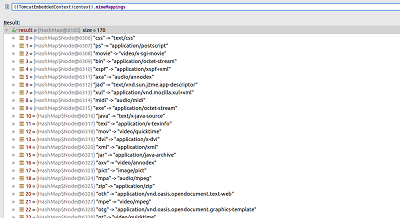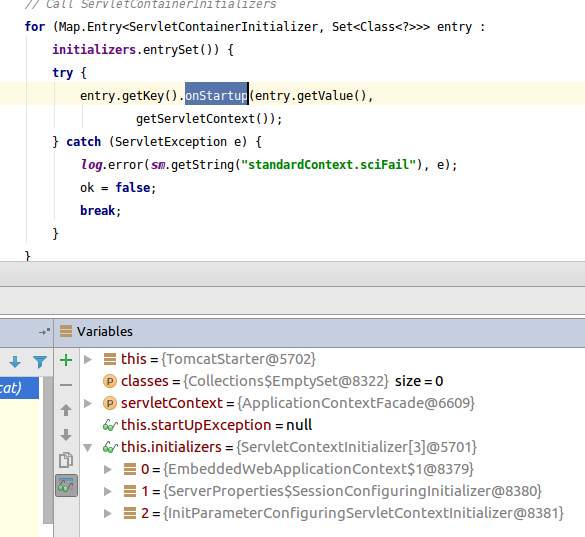您好,登錄后才能下訂單哦!
您好,登錄后才能下訂單哦!
本篇文章給大家分享的是有關如何在Spring Boot中內嵌Tomcat并啟動,小編覺得挺實用的,因此分享給大家學習,希望大家閱讀完這篇文章后可以有所收獲,話不多說,跟著小編一起來看看吧。
createEmbeddedServletContainer創建了內嵌的Servlet容器,我用的是默認的Tomcat。
private void createEmbeddedServletContainer() {
EmbeddedServletContainer localContainer = this.embeddedServletContainer;
ServletContext localServletContext = getServletContext();
if (localContainer == null && localServletContext == null) {
EmbeddedServletContainerFactory containerFactory = getEmbeddedServletContainerFactory();
this.embeddedServletContainer = containerFactory
.getEmbeddedServletContainer(getSelfInitializer());
}
else if (localServletContext != null) {
try {
getSelfInitializer().onStartup(localServletContext);
}
catch (ServletException ex) {
throw new ApplicationContextException("Cannot initialize servlet context",
ex);
}
}
initPropertySources();
}getEmbeddedServletContainerFactory方法中調用了ServerProperties,從ServerProperties的實例方法customize可以看出Springboot支持三種內嵌容器的定制化配置:Tomcat、Jetty、Undertow。
這里直接說TomcatEmbeddedServletContainerFactory的getEmbeddedServletContainer方法了,原因在前面那篇里說過了。不過首先是getSelfInitializer方法先執行的:
private org.springframework.boot.web.servlet.ServletContextInitializer getSelfInitializer() {
return new ServletContextInitializer() {
@Override
public void onStartup(ServletContext servletContext) throws ServletException {
selfInitialize(servletContext);
}
};
} 將初始化的ServletContextInitializer傳給了getEmbeddedServletContainer方法。進入了getEmbeddedServletContainer方法直接就是實例化了一個Tomcat:
Tomcat tomcat = new Tomcat();
然后生成一個臨時目錄,并tomcat.setBaseDir,setBaseDir方法的注釋說Tomcat需要一個目錄用于臨時文件并且它應該是第一個被調用的方法;如果方法沒有被調用會使用默認的幾個位置system properties - catalina.base, catalina.home - $PWD/tomcat.$PORT,另外/tmp從安全角度來說不建議。
接著:
Connector connector = new Connector(this.protocol);
創建Connector過程中,靜態代碼塊:單獨抽出來寫了。RECYCLE_FACADES屬性可以通過啟動參數JAVA_OPTS來配置: -Dorg.apache.catalina.connector.RECYCLE_FACADES=,默認是false,配置成true可以提高安全性但同時性能會有些損耗,參考:http://tomcat.apache.org/tomcat-7.0-doc/config/systemprops.html和http://bztax.gov.cn/docs/security-howto.html。其他屬性不細說了,Connector構造的邏輯主要是在NIO和APR選擇中選擇一個協議,我的是org.apache.coyote.http11.Http11NioProtocol,然后反射創建實例并強轉為ProtocolHandler。關于apr,似乎是更native,性能據說更好,但我沒測,相關文檔可參考:http://tomcat.apache.org/tomcat-8.5-doc/apr.html。這里簡單提一下coyote,它的主要作用是將socket接受的信息封裝為request和response并提供給上Servlet容器,進行上下層之間的溝通,文檔我沒找到比較新的:http://tomcat.apache.org/tomcat-4.1-doc/config/coyote.html。STRICT_SERVLET_COMPLIANCE也是啟動參數控制,默認是false,配置項是org.apache.catalina.STRICT_SERVLET_COMPLIANCE,默認情況下會設置URIEncoding = "UTF-8"和URIEncodingLower = URIEncoding.toLowerCase(Locale.ENGLISH),相關詳細介紹可參考:http://tomcat.apache.org/tomcat-7.0-doc/config/systemprops.html。Connector的創建過程比較關鍵,容我單獨寫一篇吧。
Connector實例創建好了之后tomcat.getService().addConnector(connector),getService的getServer中new了一個StandardServer,StandardServer的初始化主要是創建了globalNamingResources(globalNamingResources主要用于管理明明上下文和JDNI上下文),并根據catalina.useNaming判斷是否注冊NamingContextListener監聽器給lifecycleListeners。創建Server之后initBaseDir,先讀取catalina.home配置System.getProperty(Globals.CATALINA_BASE_PROP),如果沒取到則使用之前生成的臨時目錄,這段直接看代碼吧:
protected void initBaseDir() {
String catalinaHome = System.getProperty(Globals.CATALINA_HOME_PROP);
if (basedir == null) {
basedir = System.getProperty(Globals.CATALINA_BASE_PROP);
}
if (basedir == null) {
basedir = catalinaHome;
}
if (basedir == null) {
// Create a temp dir.
basedir = System.getProperty("user.dir") +
"/tomcat." + port;
}
File baseFile = new File(basedir);
baseFile.mkdirs();
try {
baseFile = baseFile.getCanonicalFile();
} catch (IOException e) {
baseFile = baseFile.getAbsoluteFile();
}
server.setCatalinaBase(baseFile);
System.setProperty(Globals.CATALINA_BASE_PROP, baseFile.getPath());
basedir = baseFile.getPath();
if (catalinaHome == null) {
server.setCatalinaHome(baseFile);
} else {
File homeFile = new File(catalinaHome);
homeFile.mkdirs();
try {
homeFile = homeFile.getCanonicalFile();
} catch (IOException e) {
homeFile = homeFile.getAbsoluteFile();
}
server.setCatalinaHome(homeFile);
}
System.setProperty(Globals.CATALINA_HOME_PROP,
server.getCatalinaHome().getPath());
}然后又實例化了個StandardService,代碼并沒有什么特別的:
service = new StandardService();
service.setName("Tomcat");
server.addService( service )server.addService( service )這里除了發布了一個PropertyChangeEvent事件,也沒做什么特別的,最后返回這個server。addConnector的邏輯和上面addService沒什么區別。然后是customizeConnector,這里設置了Connector的端口、編碼等信息,并將“bindOnInit”和對應值false寫入了最開頭說的靜態代碼塊中的replacements集合,IntrospectionUtils.setProperty(protocolHandler, repl, value)通過反射的方法將protocolHandler實現對象的setBindOnInit存在的情況下(拼字符串拼出來的)set為前面的false,這個方法里有大量的判斷比如參數類型及setter的參數類型,比如返回值類型以及沒找到還會try a setProperty("name", "value")等,setProperty可以處理比如AbstractEndpoint中有個HashMap<String, Object> attributes的屬性時會attributes.put(name, value)。如果是ssl還會執行customizeSsl方法,設置一些SSL用的屬性比如協議比如秘鑰還有可以用上秘鑰倉庫等。如果配置了壓縮,這里還會給協議的相關setter設置值。tomcat.setConnector(connector)不解釋。tomcat.getHost().setAutoDeploy(false),getHost方法中創建了StandardHost并設置host名(例如localhost),并getEngine().addChild( host );然后設置host的自動部署。configureEngine(tomcat.getEngine()),getEngine中如果engine為null就初始化標準引擎,設置名字為Tomcat,設置Realm和service.setContainer(engine),不過這里engine已經在getHost初始化過了所以直接返回;configureEngine方法先設置引擎的后臺進程延遲,并將引擎的Value對象注冊給引擎的pipeline,此時尚無value對象實例。這里簡單說明一下:value對象在Tomcat的各級容器中都有標準類型,并且各級容器都有一個pipeline,在請求處理過程中會從各級的第一個value對象開始依次執行一遍,value用于加入到對應的各級容器的邏輯,默認有一個標注value實現,名字類似StandardHostValue。
prepareContext(tomcat.getHost(), initializers),initializers這里是AnnotationConfigEmbeddedWebApplicationContext,Context級的根;準備Context的過程主要設置Base目錄,new一個TomcatEmbeddedContext并在構造中判斷了下loadOnStartup方法是否被重寫;注冊一個FixContextListener監聽,這個監聽用于設置context的配置狀態以及是否加入登錄驗證的邏輯;context.setParentClassLoader;設置各種語言的編碼映射,我這里是en和fr設置為UTF-8,此處可以使用配置文件org/apache/catalina/util/CharsetMapperDefault .properties;設置是否使用相對地址重定向useRelativeRedirects=false,此屬性應該是Tomcat 8.0.30版本加上的;接著就是初始化webapploader,這里和完整版的Tomcat有點不一樣,它用的是虛擬機的方式,會將加載類向上委托loader.setDelegate(true),context.setLoader(loader);之后就開始創建Wapper了,至此engine,host,context及wrapper四個層次的容器都創建完了:
private void addDefaultServlet(Context context) {
Wrapper defaultServlet = context.createWrapper();
defaultServlet.setName("default");
defaultServlet.setServletClass("org.apache.catalina.servlets.DefaultServlet");
defaultServlet.addInitParameter("debug", "0");
defaultServlet.addInitParameter("listings", "false");
defaultServlet.setLoadOnStartup(1);
// Otherwise the default location of a Spring DispatcherServlet cannot be set
defaultServlet.setOverridable(true);
context.addChild(defaultServlet);
addServletMapping(context, "/", "default");
}connector從socket接收的數據,解析成HttpServletRequest后就會經過這幾層容器,有容器各自的Value對象鏈依次處理。
接著是是否注冊jspServlet,jasperInitializer和StoreMergedWebXmlListener我這里是都沒有的。接著的mergeInitializers方法:
protected final ServletContextInitializer[] mergeInitializers(
ServletContextInitializer... initializers) {
List<ServletContextInitializer> mergedInitializers = new ArrayList<ServletContextInitializer>();
mergedInitializers.addAll(Arrays.asList(initializers));
mergedInitializers.addAll(this.initializers);
return mergedInitializers
.toArray(new ServletContextInitializer[mergedInitializers.size()]);
}
configureContext(context, initializersToUse)對context做了些設置工作,包括TomcatStarter(實例化并set給context),LifecycleListener,contextValue,errorpage,Mime,session超時持久化等以及一些自定義工作:
TomcatStarter starter = new TomcatStarter(initializers);
if (context instanceof TomcatEmbeddedContext) {
// Should be true
((TomcatEmbeddedContext) context).setStarter(starter);
}
context.addServletContainerInitializer(starter, NO_CLASSES);
for (LifecycleListener lifecycleListener : this.contextLifecycleListeners) {
context.addLifecycleListener(lifecycleListener);
}
for (Valve valve : this.contextValves) {
context.getPipeline().addValve(valve);
}
for (ErrorPage errorPage : getErrorPages()) {
new TomcatErrorPage(errorPage).addToContext(context);
}
for (MimeMappings.Mapping mapping : getMimeMappings()) {
context.addMimeMapping(mapping.getExtension(), mapping.getMimeType());
}
Session如果不需要持久化會注冊一個DisablePersistSessionListener。其他定制化操作是通過TomcatContextCustomizer的實現類實現的:

context配置完了作為child add給host,add時給context注冊了個內存泄漏跟蹤的監聽MemoryLeakTrackingListener。postProcessContext(context)方法是空的,留給子類重寫用的。
getEmbeddedServletContainer方法的最后一行:return getTomcatEmbeddedServletContainer(tomcat)。
protected TomcatEmbeddedServletContainer getTomcatEmbeddedServletContainer(
Tomcat tomcat) {
return new TomcatEmbeddedServletContainer(tomcat, getPort() >= 0);
}TomcatEmbeddedServletContainer的構造函數:
public TomcatEmbeddedServletContainer(Tomcat tomcat, boolean autoStart) {
Assert.notNull(tomcat, "Tomcat Server must not be null");
this.tomcat = tomcat;
this.autoStart = autoStart;
initialize();
}initialize的第一個方法addInstanceIdToEngineName對全局原子變量containerCounter+1,由于初始值是-1,所以addInstanceIdToEngineName方法內后續的獲取引擎并設置名字的邏輯沒有執行:
private void addInstanceIdToEngineName() {
int instanceId = containerCounter.incrementAndGet();
if (instanceId > 0) {
Engine engine = this.tomcat.getEngine();
engine.setName(engine.getName() + "-" + instanceId);
}
}initialize的第二個方法removeServiceConnectors,將上面new的connection以service(這里是StandardService[Tomcat])做key保存到private final Map<Service, Connector[]> serviceConnectors中,并將StandardService中的protected Connector[] connectors與service解綁(connector.setService((Service)null);),解綁后下面利用LifecycleBase啟動容器就不會啟動到Connector了。
之后是this.tomcat.start(),這段比較復雜,我單獨總結一篇吧。
TomcatEmbeddedServletContainer的初始化,接下來是rethrowDeferredStartupExceptions,這個方法檢查初始化過程中的異常,如果有直接在主線程拋出,檢查方法是TomcatStarter中的private volatile Exception startUpException,這個值是在Context啟動過程中記錄的:

@Override
public void onStartup(Set<Class<?>> classes, ServletContext servletContext)
throws ServletException {
try {
for (ServletContextInitializer initializer : this.initializers) {
initializer.onStartup(servletContext);
}
}
catch (Exception ex) {
this.startUpException = ex;
// Prevent Tomcat from logging and re-throwing when we know we can
// deal with it in the main thread, but log for information here.
if (logger.isErrorEnabled()) {
logger.error("Error starting Tomcat context. Exception: "
+ ex.getClass().getName() + ". Message: " + ex.getMessage());
}
}
}Context context = findContext():
private Context findContext() {
for (Container child : this.tomcat.getHost().findChildren()) {
if (child instanceof Context) {
return (Context) child;
}
}
throw new IllegalStateException("The host does not contain a Context");
}綁定命名的上下文和classloader,不成功也無所謂:
try {
ContextBindings.bindClassLoader(context, getNamingToken(context),
getClass().getClassLoader());
}
catch (NamingException ex) {
// Naming is not enabled. Continue
}startDaemonAwaitThread方法的注釋是:與Jetty不同,Tomcat所有的線程都是守護線程,所以創建一個非守護線程(例:Thread[container-0,5,main])來避免服務到這就shutdown了:
private void startDaemonAwaitThread() {
Thread awaitThread = new Thread("container-" + (containerCounter.get())) {
@Override
public void run() {
TomcatEmbeddedServletContainer.this.tomcat.getServer().await();
}
};
awaitThread.setContextClassLoader(getClass().getClassLoader());
awaitThread.setDaemon(false);
awaitThread.start();
}這個await每10秒檢查一次是否關閉了:
try {
awaitThread = Thread.currentThread();
while(!stopAwait) {
try {
Thread.sleep( 10000 );
} catch( InterruptedException ex ) {
// continue and check the flag
}
}
} finally {
awaitThread = null;
}
return;回到EmbeddedWebApplicationContext,initPropertySources方法,用初始化好的servletContext完善環境變量:
/**
* {@inheritDoc}
* <p>Replace {@code Servlet}-related property sources.
*/
@Override
protected void initPropertySources() {
ConfigurableEnvironment env = getEnvironment();
if (env instanceof ConfigurableWebEnvironment) {
((ConfigurableWebEnvironment) env).initPropertySources(this.servletContext, null);
}
}createEmbeddedServletContainer就結束了,內嵌容器的啟動過程至此結束。
以上就是如何在Spring Boot中內嵌Tomcat并啟動,小編相信有部分知識點可能是我們日常工作會見到或用到的。希望你能通過這篇文章學到更多知識。更多詳情敬請關注億速云行業資訊頻道。
免責聲明:本站發布的內容(圖片、視頻和文字)以原創、轉載和分享為主,文章觀點不代表本網站立場,如果涉及侵權請聯系站長郵箱:is@yisu.com進行舉報,并提供相關證據,一經查實,將立刻刪除涉嫌侵權內容。